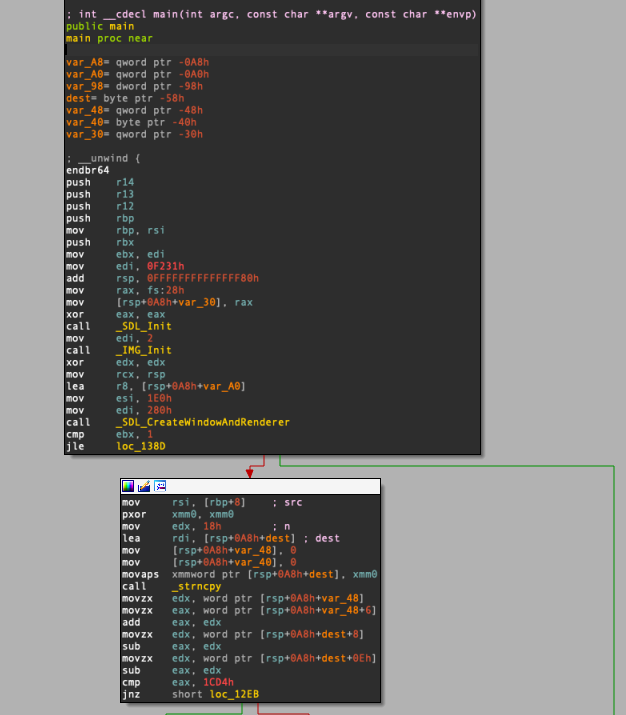Background
Recently Hex Rays released a reversing challenge called “Free Madame de Maintenon” and this is a brief write up that documented the process of solving it.
Challenge
File
1
2
3
➜ file challenge
challenge: ELF 64-bit LSB pie executable, x86-64, version 1 (SYSV), dynamically linked, interpreter /lib64/ld-linux-x86-64.so.2, BuildID[sha1]=83db7b297901c743a71f43e813e3dc266245b220, for GNU/Linux 3.2.0, stripped
Protections
1
2
3
4
5
6
7
8
9
10
➜ checksec
[*] '/home/careless/Desktop/play-ground/ctf/Others/challenge'
Arch: amd64-64-little
RELRO: Full RELRO
Stack: Canary found
NX: NX enabled
PIE: PIE enabled
FORTIFY: Enabled
Symbol Table
1
2
3
4
5
6
7
8
9
10
11
12
13
14
15
16
17
18
19
20
21
22
23
24
25
26
27
➜ objdump -T challenge
challenge: file format elf64-x86-64
DYNAMIC SYMBOL TABLE:
0000000000000000 DF *UND* 0000000000000000 Base SDL_DestroyWindow
0000000000000000 DF *UND* 0000000000000000 Base SDL_Quit
0000000000000000 DF *UND* 0000000000000000 Base SDL_RenderPresent
0000000000000000 DF *UND* 0000000000000000 Base SDL_CreateWindowAndRenderer
0000000000000000 DF *UND* 0000000000000000 Base SDL_DestroyRenderer
0000000000000000 DF *UND* 0000000000000000 (GLIBC_2.2.5) strncpy
0000000000000000 DF *UND* 0000000000000000 Base SDL_PollEvent
0000000000000000 DF *UND* 0000000000000000 (GLIBC_2.34) __libc_start_main
0000000000000000 DF *UND* 0000000000000000 Base SDL_Init
0000000000000000 DF *UND* 0000000000000000 Base IMG_Init
0000000000000000 DF *UND* 0000000000000000 Base SDL_RenderClear
0000000000000000 DF *UND* 0000000000000000 (GLIBC_2.4) __stack_chk_fail
0000000000000000 DF *UND* 0000000000000000 Base SDL_RenderCopy
0000000000000000 DF *UND* 0000000000000000 Base SDL_RWFromConstMem
0000000000000000 DF *UND* 0000000000000000 Base IMG_LoadTexture_RW
0000000000000000 DF *UND* 0000000000000000 (GLIBC_2.3.4) __fprintf_chk
0000000000000000 w D *UND* 0000000000000000 Base _ITM_deregisterTMCloneTable
0000000000000000 w D *UND* 0000000000000000 Base __gmon_start__
0000000000000000 w D *UND* 0000000000000000 Base _ITM_registerTMCloneTable
0000000000000000 w DF *UND* 0000000000000000 (GLIBC_2.2.5) __cxa_finalize
000000000015df60 g DO .bss 0000000000000008 (GLIBC_2.2.5) stderr
0000000000001220 g DF .text 00000000000002dc Base main
Run
1
2
➜ ./challenge
You need to give the password as the argument%
With Password:
1
➜ ./challenge 1234
IDA & Disassembly
This program expects the password with the length of 24 (mov edx, 18h) and performs some operations and checks on it. The result of such operations are used with what I would call it “image” buffer in .data section in order to produce the final image. The goal here is to find the password that produces the “correct” image.
Operations
These are (roughly) the necessary conditions to meet in order to reach the “success” block:
1
2
3
4
5
6
7
8
9
10
11
12
13
14
15
16
17
18
19
20
21
22
23
24
25
26
27
28
29
30
31
32
33
34
35
36
37
38
39
// Condition 1
if((flag[16:18] + flag[22:24] - flag[8:10] - flag[14:16]) != 0x1cd4){
JMP_TO_FAIL;
}
// Condition 2
if ((flag[20:22] + flag[6:8] + flag[2:4] - flag[10:12]) != 0xd899){
JMP_TO_FAIL;
}
// Condition 3
if ((flag[16:] ^ flag[0:8]) != 0xA04233A475D1B72){
JMP_TO_FAIL;
}
// Condition 4
while (counter != 0x1d9AD){
buffer[8 * counter] -= flag[counter] - ((0xAAAAAAAAAAAAAAAB * counter >> 64) >> 1) + (0xAAAAAAAAAAAAAAAB * counter >> 64) & 0xFFFFFFFFFFFFFFFE)
++counter;
}
if (flag[20:24] + (flag[0:4] * 2) - (4 * flag[8:12]) - (flag[16:20] >> 3) - (flag[4:8] >> 3) != 0x4B5469C){
JMP_TO_FAIL;
}
// Condition 5
idx = 0
counter = 1;
while (counter <= 0x3B35A){
&buffer[4 * idx] ^= flag;
counter += idx;
offset = (offest + 1) % 6
idx = counter;
}
if((flag[8:16] ^ flag[16:]) != 0x231F0B21595D0455){
JMP_TO_FAIL;
}
Initial Attempt with Z3
1
2
3
4
5
6
7
8
9
10
11
12
13
14
15
from z3 import *
flag = [BitVec(f"flag_{i:02}",16) for i in range(0,12)]
s = Solver()
s.add((flag[8] + flag[-1]-flag[4]-flag[7]) == 0x1cd4)
s.add((flag[3] + flag[1] + flag[-2] - flag[5]) == 0xd899)
if repr(s.check()) == "sat":
m = s.model()
solution = sorted([(d, m[d].as_long()) for d in m], key=lambda x: str(x[0]))
print (b''.join([struct.pack("<H",int(str(x[1]),10)) for x in solution]))
...
Result:
1
2
➜ python solver.py
b'/\x08J\x11\x01\x08\x88\x02\x9d\x03\x99p\x01@aA\x84\x01l\x08`5N`'
It was not clear to me at the time of writing (now I do know for sure) whether it was possible to modify the size of what was originally defined in BitVec (for 64bit xor in the challenge). This was a good refresher on some of the quirks and available functions in z3. Regardless, I spent a long enough time on z3 and moved onto other method.
Angr
Angr, which is every CTF player’s go-to tool for symoblic execution, is a great choice for this case. It is still necessary to provide the constraints and such but at least it would steps through every basic blocks and find the input that satisfies the condition (if it exists) for me. However, there are a few things to note for this challenge:
1
2
3
4
1. Argv[1],which is our password,does get copied into some buffer on the stack. It is recommended to load our BitVec via hooks directly into the password buffer ([rsp+0x50]). Also, make sure to remove \n,\r,\t,[space] characters for strncpy.
2. There is a check whether SDL_CreateWindowAndRenderer was successful or not (by checking the returned value greater than 1). Since I have excluded all SDL related functions via exclude_sim_procedures_list, I hooked into the address right after the call to set its value to greater than 1.
3. Patch the block that loads the failed image (offset 0x12F7) via SDL_RWFromConstMem. This is done to make sure it does not poll and simply exits when it fails.
4. There is an issue with loading the address of image buffer to rbp (offset 0x13d0) for some reason. I got around by manually setting the register via hooks.
With the above notes in mind, this is the solution script I came up with for the challenge:
1
2
3
4
5
6
7
8
9
10
11
12
13
14
15
16
17
18
19
20
21
22
23
24
25
26
27
28
29
30
31
32
33
34
35
36
37
38
39
40
41
42
43
44
45
46
47
48
49
50
51
52
53
54
55
56
57
58
59
60
61
62
63
import angr
import claripy
project = angr.Project("./challenge", auto_load_libs=False, exclude_sim_procedures_list=["strncpy","SDL_Init","IMG_Init","SDL_CreateWindowAndRenderer"])
argv1 = claripy.BVS("argv1",24*8)
#0x400000
def check(state):
if state.ip.args[0] == 0x401272:
state.regs.rdx = 2
if state.ip.args[0] == 0x4012a5:
state.memory.store(state.regs.rsp+0x50,argv1)
@project.hook(0x401272)
def set_ebx(state):
state.regs.rdx = 0x2
@project.hook(0x4012a5)
def set_ebx(state):
state.memory.store(state.regs.rsp+0x50,argv1)
@project.hook(0x4013d0)
def set_buffer(state):
state.regs.rbp = 0x400000 + 0x711e0
@project.hook(0x4014e2)
def write_buffer(state):
data = state.memory.load(0x400000 + 0x711e0,506764)
buffer = state.solver.eval(data,cast_to=bytes)
with open("x.png","wb") as f:
f.write(buffer)
init_state = project.factory.entry_state(args=["./challenge","1"*24])
for x in argv1.chop(8):
init_state.solver.add(x != 0x20)
init_state.solver.add(x != 0x0a)
init_state.solver.add(x != 0x0d)
init_state.solver.add(x != 0x9)
init_state.solver.add(x > 0)
init_state.solver.add(x != 0)
init_state.solver.add(x > 0x20)
init_state.solver.add(x < 0x7f)
sm = project.factory.simulation_manager(init_state)
if len(sm.found) > 0:
print (len(sm.found))
print (sm.found)
print (sm.deadended)
for x in sm.found:
a = x.solver.eval(argv1, cast_to=bytes)
payload = ""
for i in a:
payload += f'\\x{i:02x}'
print (payload)
else:
print ("No Solution Found!")
It does take a bit to run but eventually it shows the following password:
1
2
➜ python solver.py
\x46\x72\x33\x33\x5f\x4d\x34\x64\x61\x6d\x33\x2d\x44\x65\x2f\x4d\x34\x69\x6e\x74\x65\x6e\x30\x6e #Fr33_M4dam3-De/M4inten0n
Verifying the above password with the challenge:
Conclusion
It was a little fun challenge to poke at and thanks to Hex Rays team for putting it out. I am hoping to see more fun challenges in the future :)



